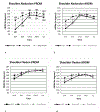Five-Year Cumulative Incidence of Axillary Web Syndrome and Comparison in Upper Extremity Movement, Function, Pain, and Lymphedema in Survivors of Breast Cancer With and Without Axillary Web Syndrome
- PMID: 35398047
- PMCID: PMC9452471
- DOI: 10.1016/j.apmr.2022.03.007
Five-Year Cumulative Incidence of Axillary Web Syndrome and Comparison in Upper Extremity Movement, Function, Pain, and Lymphedema in Survivors of Breast Cancer With and Without Axillary Web Syndrome
Abstract
Objective: To determine the cumulative incidence and natural history of axillary web syndrome (AWS) and its related postoperative risk for physical impairments in a cohort of women followed for 5 years post breast cancer surgery.
Design: Prospective, longitudinal study.
Setting: Academic health center.
Participants: Women (N=36) with and without AWS after breast cancer surgery with sentinel node biopsy or axillary lymph node dissection.
Interventions: Not applicable.
Main outcome measures: Participants were assessed for AWS, shoulder goniometric flexion and abduction range of motion, function (Disability of the Arm, Shoulder, and Hand), lymphedema (bioimpedance spectroscopy, girth measures, tissue dielectric constant), and pain (visual analog scale) at 2, 4, 12, and 78 weeks and 5 years after breast cancer surgery. Analysis of variance compared range of motion, function, lymphedema, and pain in women identified with AWS with those without AWS across visits. Univariate logistic regression assessed if AWS was a risk factor for physical impairment at 5 years.
Results: The cumulative incidence of AWS was 57%. Fifty percent (14/28) of the women who completed all study visits had signs of AWS at 5 years. Abduction active range of motion was significantly lower in women with AWS at 2 and 4 weeks post surgery. AWS was identified as a risk factor for reduced shoulder motion at 5 years. Regardless of AWS, 75% of the women experienced 1 or more upper extremity physical impairments at 5 years, which is an increase from 66% at 78 weeks in the same cohort.
Conclusions: AWS is associated with reduced shoulder range of motion in the early postoperative time period, can persist for 5 years after breast cancer surgery, and increases the risk of long-term reduced shoulder range of motion. Long-term physical issues are apparent after breast cancer surgery regardless of AWS.
Keywords: Breast neoplasms; Incidence; Lymphedema; Rehabilitation.
Copyright © 2022 American Congress of Rehabilitation Medicine. Published by Elsevier Inc. All rights reserved.
Conflict of interest statement
Conflicts of interest: None of the authors have any conflict of interest to report.
Figures



Similar articles
-
Is axillary web syndrome a risk factor for breast cancer-related lymphedema of the upper extremity? A systematic review and meta-analysis.Breast Cancer Res Treat. 2024 Dec;208(3):471-490. doi: 10.1007/s10549-024-07518-0. Epub 2024 Oct 16. Breast Cancer Res Treat. 2024. PMID: 39414730
-
Function, Shoulder Motion, Pain, and Lymphedema in Breast Cancer With and Without Axillary Web Syndrome: An 18-Month Follow-Up.Phys Ther. 2018 Jun 1;98(6):518-527. doi: 10.1093/ptj/pzy010. Phys Ther. 2018. PMID: 29361075 Free PMC article.
-
The upper-limb volumetric changes in breast cancer survivors with axillary web syndrome.Eur J Cancer Care (Engl). 2017 Mar;26(2). doi: 10.1111/ecc.12637. Epub 2017 Feb 9. Eur J Cancer Care (Engl). 2017. PMID: 28181311
-
Movement, Function, Pain, and Postoperative Edema in Axillary Web Syndrome.Phys Ther. 2015 Oct;95(10):1345-53. doi: 10.2522/ptj.20140377. Epub 2015 May 14. Phys Ther. 2015. PMID: 25977305 Free PMC article.
-
Web Axillary Pain Syndrome-Literature Evidence and Novel Rehabilitative Suggestions: A Narrative Review.Int J Environ Res Public Health. 2021 Oct 2;18(19):10383. doi: 10.3390/ijerph181910383. Int J Environ Res Public Health. 2021. PMID: 34639683 Free PMC article. Review.
Cited by
-
A Case of Axillary Web Syndrome Caused by Venous Blood Sampling.Healthcare (Basel). 2023 Aug 25;11(17):2390. doi: 10.3390/healthcare11172390. Healthcare (Basel). 2023. PMID: 37685424 Free PMC article.
-
Exploring the links of skeletal muscle mitochondrial oxidative capacity, physical functionality, and mental well-being of cancer survivors.Sci Rep. 2024 Feb 1;14(1):2669. doi: 10.1038/s41598-024-52570-x. Sci Rep. 2024. PMID: 38302539 Free PMC article.
-
Development of a core set of outcome measures to be applied toward breast cancer-related lymphedema core outcome domains.Breast Cancer Res Treat. 2024 Jun;205(3):439-449. doi: 10.1007/s10549-024-07298-7. Epub 2024 Mar 22. Breast Cancer Res Treat. 2024. PMID: 38517603 Free PMC article. Review.
-
Is axillary web syndrome a risk factor for breast cancer-related lymphedema of the upper extremity? A systematic review and meta-analysis.Breast Cancer Res Treat. 2024 Dec;208(3):471-490. doi: 10.1007/s10549-024-07518-0. Epub 2024 Oct 16. Breast Cancer Res Treat. 2024. PMID: 39414730
References
Publication types
MeSH terms
Grants and funding
LinkOut - more resources
Full Text Sources
Medical

